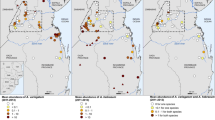Summary
Reproductive interference between three species of reptile tick, Aponomma hydrosauri, Amblyomma albolimbatum and Amb. limbatum was investigated. Adults of two species attach together on the same lizard hosts in narrow overlap zones at parapatric boundaries between species, providing opportunities for interference. The possibility of reproductive interference was suggested because of similarities in the sexual communication systems.
Three forms of interference were found in laboratory experiments. Firstly male movement to search for sexually receptive females was inhibited when females of two species were present on the same host, probably because of signal interference. Secondly, a nonspecific, short range attractant pheromone led males into non-conspecific courtship attempts which reduced the time for conspecific courtships. Thirdly Amb. albolimbatum males physically blocked the genitalia of female Ap. hydrosauri after unsuccessful non-conspecific courtship attempts. Field data showed this behaviour was common in both Amblyomma species after conspecific matings. Reproductive interference would reduce the fitness of each species in sympatry, and may contribute to the maintenance of the narrow parapatric boundaries.
Similar content being viewed by others
References
Andrewartha HG, Birch LC (1954) The distribution and abundance of animals. University of Chicago Press, Chicago
Andrews RH (1981) Mating behaviour and sexual isolation of three species of reptile tick. Anim Behav (in press)
Andrews RH, Bull CM (1980) Mating behaviour in the Australian reptile tick Aponomma hydrosauri. Anim Behav 28:1280–1286
Andrews RH, Bull CM (1981a) Inhibition of mating behaviour before feeding in the tick Aponomma hydrosauri. Anim Behav 29:512–518
Andrews RH, Bull CM (1981b) An attractant pheromone with common properties in three reptile ticks. Experientia (in press)
Andrews RH, Petney TN (1981) Competition for sites of attachment to hosts in three parapatric species of reptile tick. Oecologia (Berl) (in press)
Andrews RH, Petney TN, Bull CM (1981) Niche changes between parasite populations: an example from reptile ticks. (M.S.)
Bull CM (1978a) Heterogeneity of resource utilization in a population of the Australian reptile tick, Aponomma hydrosauri (Denny). Ecol Entomol 3:171–179
Bull CM (1978b) Dispersal of the Australian reptile tick Aponomma hydrosauri by host movement. Aust J Zool 26:686–697
Bull CM, King DR (1981) A parapatric boundary between two species of reptile ticks in the Albany area, Western Australia. Trans Roy Soc S Aust (in press)
Bull CM, Sharrad RD, Petney TN (1981) Parapatric boundaries between Australian reptile ticks. Proc Ecol Soc Aust (in press)
Endler JA (1977) Geographic variation, speciation and clines. Princeton University Press, Princeton
Grant PR (1975) The classical case of character displacement. Evolut Biol 8:237–337
Lanier GN (1970) Biosystematics of north American Ips (Coleoptera: Scolytidae). Hopping's group IX. Can Entomol 102:1139–1163
Littlejohn MJ (1965) Premating isolation in the Hyla ewingi complex. Evolution 19:234–243
Littlejohn MJ, Martin AA (1969) Acoustic interaction between two species of leptodactylid frogs. Anim Behav 17:788–789
Loftus-Hills JJ (1975) The evidence for reproductive character displacement between the toads Bufo americanus and B. woodhousii fowleri. Evolution 29:368–369
MacNally RC (1979) Social organization and interspecific interactions in two sympatric species of Ranidella (Anura). Oecologia (Berl) 42:293–306
Odendaal FJ, Bull CM (1981) Differences in the intensity of the male mating call of Ranidella signifera and R. riparia (Anura: Leptodactylidae). (MS)
Parker GA (1978) Evolution of competitive mate searching. Ann Rev Entomol 23:173–196
Paterson HE (1978) More evidence against speciation by reinforcement. S Afr J Sci 74:369–371
Petney TN (1981) Interactions of two parapatric species of reptile ticks with their off host environment. PhD Thesis, Flinders University of South Australia
Roelofs WL, Cardé RT (1974) Sex pheromones in the reproductive isolation of lepidopterous species Pages 96–114 In: MC Birch (ed) Pheromones. North-Holland, Amsterdam
Schoener TW (1974) Resource partitioning in ecological communities. Science 188:27–39
Sharrad RD (1980) Studies of factors which determine the parapatric distributions of South Australian reptile ticks. PhD thesis, Adelaide University
Sharrad RD, King DR (1981) The geographical distribution of reptile ticks in Western Australia. Aust J Zool (in press)
Smyth M (1973) The distribution of three species of reptile ticks, Aponomma hydrosauri Denny, Amblyomma albolimbatum Neumann and Amb. limbatum Neumann. I. Distribution and hosts. Aust J Zool 21:91–101
Tamaki Y (1977) Behaviour modifying chemicals in lepidoptera and diptera. In: HH Shorey and JJ McKelvey Jr (eds) Chemical control of insect behaviour: theory and application. Wiley, New York pp 283–285
Trivers RL (1972) Parental investment and sexual selection. In: Campbell (ed). Sexual selection and the descent of man. Aldine-Atherton, Chicago pp 136–179
Wood WF, Leahy MG, Galun R, Prestwich GD, Meinwald J, Purnell RE and Payne RC (1975) Phenols as pheromones of ixodid ticks: a general phenomenon. J Chem Ecol 1:501–509
Author information
Authors and Affiliations
Rights and permissions
About this article
Cite this article
Andrews, R.H., Petney, T.N. & Bull, C.M. Reproductive interference between three parapatric species of reptile tick. Oecologia 52, 281–286 (1982). https://doi.org/10.1007/BF00363851
Received:
Issue Date:
DOI: https://doi.org/10.1007/BF00363851




